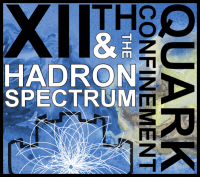Speaker
Description
X
Summary
An intuitive picture of confinement was first proposed by Gribov in which the color-Coulomb potential provides the long-range confining force. This picture has been successfully studied by Hamiltonian methods. We propose here to develop a non-perturbative calculational scheme adapted to local Lagrangian quantum field theory in Coulomb gauge. We are encouraged to do so because of the theorem, ``No confinement without Coulomb confinement," which asserts that if the gauge-invariant Wilson potential $V_W(r)$ is confining, then the color-Coulomb potential $V(r)$ is more strongly attractive than $V_W(r)$ at large $r$, $V(r) > V_W(r)$. The color-Coulomb potential is the instantaneous part of the time-time component of the gluon propagator $D_{00}(x) = V(r) \delta(t) + P(x)$, where $V(r)$ is the instantaneous color-Coulomb potential and $P(x)$ is non-instantaneous.
Starting from the local Lagrangian of quantum gauge field theory in Coulomb gauge, we develop a truncation scheme for a closed set of Schwinger-Dyson (SD) equations that involves only one time. The propagators that appear are either instantaneous, such as $V(r)$, or at equal time, such as the space-space components of the gluon propgator $D_{i j}^{ET}(\vec x - \vec y) \equiv D_{ij}(x - y)|_{x_0 = y_0}$. The local Lagrangian in Coulomb gauge may be either of Yang-Mills type or of the type developed by Gribov and Zwanziger.




